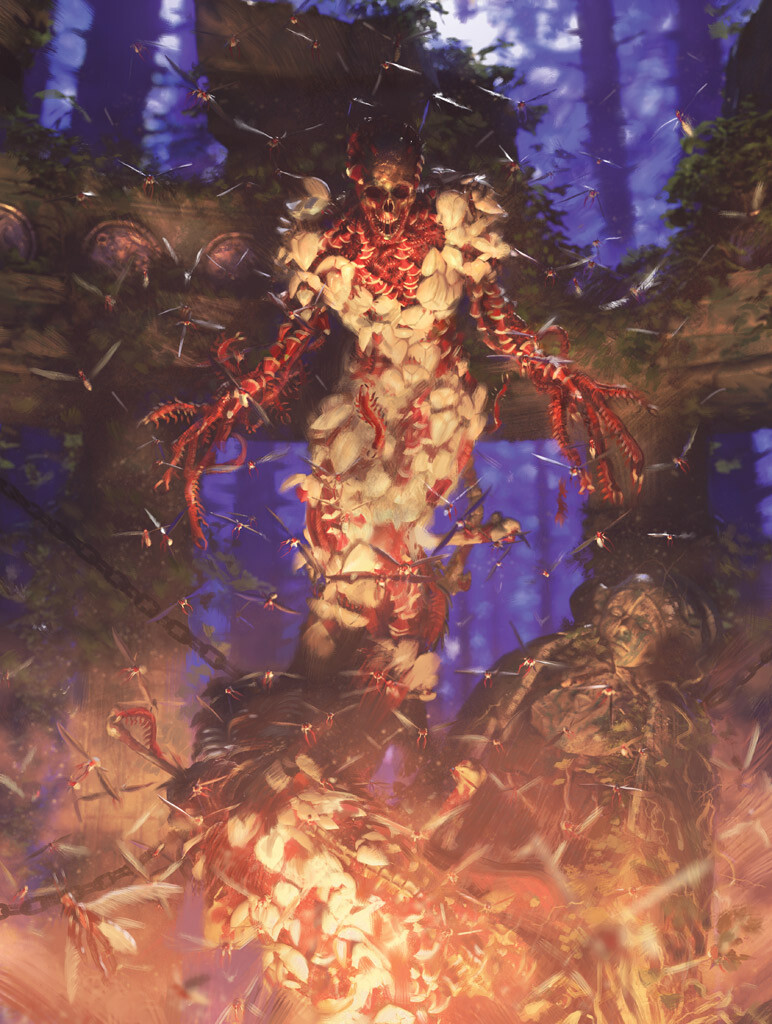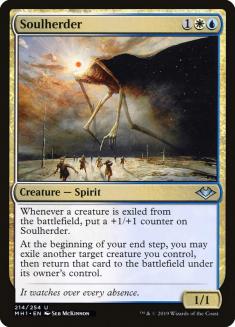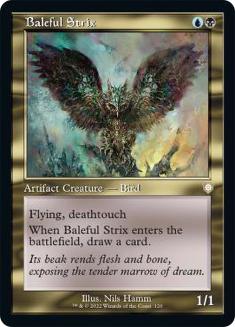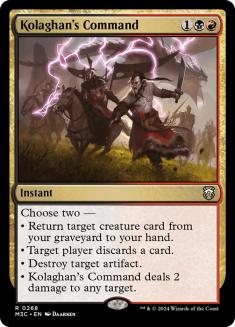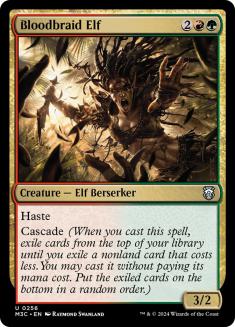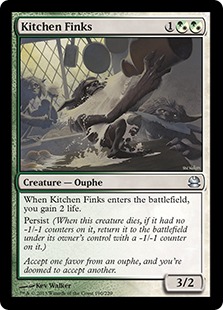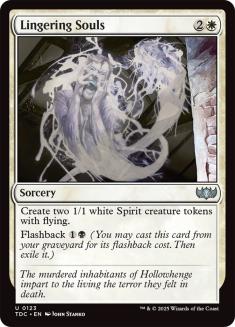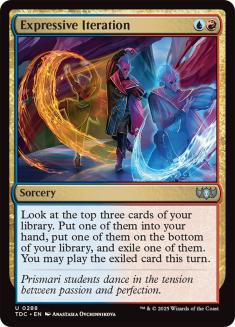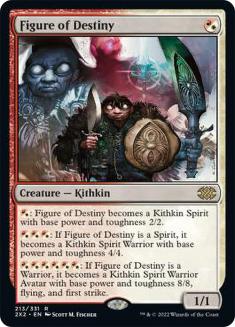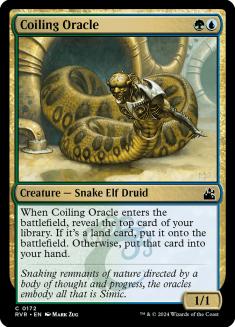Happy August, gamers, and welcome to yet another entry in my series on the list of the most Cubeable cards in Magic! Last week marked the conclusion of the mono-color entries with green, and this week I’ll be going over my picks for the most Cubeable gold cards.
Today’s entry will be significantly different than previous entries. Rather than identify which cards that are more than one color are the biggest value add to Cube without weighing their colors it makes more sense to me to talk about all ten two-color pairs and to select a most Cubeable card for each pairing. This will also give me the opportunity to talk about the strengths and weaknesses of each color pair, which is something that comes up in pretty big ways when you design a Cube. I should also say that I have a strong bias towards selecting two-color cards that give players a reason to commit to playing both colors. Maelstrom Pulse and Detention Sphere aren’t different enough from Oblivion Ring to make many of my Cubes. For the most part, I’m looking for cards that really give players a reason to go gold.
This methodology means that I won’t be talking about any cards that are three or more colors today. There’s nothing wrong with Cubing with cards that are three or more colors, but they are absolutely trickier as a category than mono-color and two-color cards. There are also just way fewer cards of any three or more color combination to choose from if you’re in the market to play with any, which makes any insights I would have on these combinations less significant.
Today I won’t be counting down from ten, but instead just going over each two-color pair in WUBRG order. This is a ten card list of number ones.
Azorius – Soulherder
Azorius is among the more frustrating color combinations to work with in Cube. Archetype support is mostly limited to Do-Nothing Control, Blink, and “Fliers”, with cards that are either generically powerful or generally inefficient. Dovin Baan is too weak to show up in a lot of decks, and Teferi, Hero of Dominaria is too powerful for a lot of Cubes. Fractured Identity is right out.
Soulherder shoehorns you into offering some support for Blink decks, but the options here are slim and most Cubes are going to feature creatures worth blinking anyway. Reflector Mage would in all likelihood be my runner-up choice, with Soulherder getting the nod for being a powerful signpost that strongly signals an available archetype.
Soulherder is quite powerful, but is also quite fragile. The exact style of card that I’ve praised in this series. When I find that Soulherder decks are performing too well I’m more likely to trim back the power of the assorted enter the battlefield creatures in a Cube than to remove Soulherder, as the power of Blink decks tends to be more correlated with those things than how good your deck is at blinking creatures. Soulherder isn’t up to snuff in my ideal Vintage Cube experience, but I like the card quite a lot in many lower powered Cubes.
Dimir – Baleful Strix
Baleful Strix was actually the card that motivated me to write this series. I was marveling at how well the card played across my assorted Cubes and wondering how many cards scaled quite so well from one environment to another. Being an artifact, always replacing itself, having evasion, and trading up in combat are all great things for a card to do in Cube without being overwhelming. Baleful Strix is one of those cards that would be pretty miserable in a lot of Constructed formats that ends up being a lot more reasonable and fun when playing singleton.
Do artifacts matter in your Cube? Do you want something to do while you get your Reanimator deck set up? Does blocking matter in your Cube? Do you want a powerful enabler for Ninjas? Baleful Strix is incredibly easy to justify including. The card doesn’t have quite enough punch to be a desirable first pick in most Cubes, but it will make somebody’s deck far more often than not.
Another aspect of this pick is that there’s a wide gap before I could select a second most Cubeable Dimir card. Ashiok Nightmare Weaver is a popular card that is completely miserable to play against. Drown in the Loch is not an exciting card to draft. Shadowmage Infiltrator was never good. There’s exciting stuff when you get very specific, like Prized Amalgam and Yuriko, the Tiger’s Shadow, but these cards can’t just go into any Cube the way that Baleful Strix can.
Rakdos – Kolaghan’s Command
Rakdos is pretty long on completely serviceable removal spells, and even longer on horrible creatures. Gold cards often showcase the strengths of both colors, but Rakdos is uniquely good at showcasing the shortcomings of red and black. We’ve seen a significant improvement in Rakdos options in recent years, but the list of exciting options still isn’t all that long. It’s still the case that Terminate is a strong consideration for many Cubes, and Terminate fails the test of being better enough than Doom Blade to be an actual draw to playing multiple colors.
Kolaghan’s Command is just one of those cards that does enough. A bit of a sleeper during its preview season, the card went on to define Grixis Delver mirrors in Modern and is currently heavily played in Pioneer. You’ll get a two-for-one somehow with Kolaghan’s Command, and the more artifacts there are in your Cube the more potential the card has for total blowouts, which is very appropriate for Vintage Cube.
I find myself committing Rakdos slots to support for Sacrifice archetypes more often than not, and once you do that there are a lot of great Rakdos cards that are specific to that archetype. Judith, the Scourge Diva is a favorite of mine on those lines. I’d also offer Azra Oddsmaker as one of the most fun Cube cards you may have never heard of.
Gruul – Bloodbraid Elf
It is very common to see red Cube columns committed to being aggressive and green columns committed to casting big spells. These strategies are fundamentally at odds, which raises the question of why anybody would want to play Gruul.
Ultimately, Gruul in Cube is going to be a matter of splashing far more often than committing to the “Not Gruul? Then die!” lifestyle. This could be splashing Escape to the Wilds in your ramp deck or Bloodbraid Elf in a beatdown or midrange deck. Bloodbraid Elf is great in Peasant Cube, and while I don’t consider it much of a Vintage Cube card I do have a screenshot somewhere of me cascading into a Tinker for Blightsteel Colossus. That’s gotta count for something.
Gruul does have some problems with most of the great Gruul cards costing four, but the bigger issue is definitely that green and red just generally get up to pretty different things in Cube. Burning-Tree Emissary would have been an okay pick here with it going all the way down to Pauper, but it’s a bit more of a mono-red card masquerading as Gruul, with Bloodbraid Elf actually being a solid anchor to Gruul and Jund.
Selesnya – Kitchen Finks
If you’re at all familiar with my work, you probably saw this one coming a mile away. Kitchen Finks deviates from my stated criteria pretty significantly given that it’s definitely not a draw to drafting Selesnya, but at that, what is? Designing Grixis Cube wasn’t some strictly stylistic choice or meme. Selesnya just doesn’t do anything uniquely desirable in Cube. If you want to sell me on destroying enchantments then I would hope that your Cube at least has enchantments as more robust theme, such as with Shrines in my Peasant Twobert.
There’s just not much that you can do with Selesnya without building it up to be a significant contributor to some three color combinations. You can do tokens or counters or whatever, but no matter what you do it’s just going to make sense to try to access a third color for better interaction and/or better payoffs.
I like Kitchen Finks partly for sidestepping the Selesnya issue and just being solid in white or green decks, but the card also contributes to several archetypes. It’s a good creature for Sacrifice decks, especially if you have some support for persist combo. It’s a great creature to blink. It’s also a nice enabler for lifegain strategies. All while being solid both aggressively and defensively.
I do a fair amount of Cubing with Qasali Pridemage and Voice of Resurgence, and they’re fine cards that are better or worse from one Cube to another. At the end of the day though, it’s common to see whatever Selesnya option you choose going late in draft and not making decks. Kitchen Finks should at the very least be a relevant sideboard card for someone.
Orzhov – Lingering Souls
Orzhov is another of the less desirable color pairs, but there are a few options that are quite powerful. Lingering Souls can hang everywhere from Peasant Cube to Vintage Cube, and it’s worth noting that the card will be a little too powerful for some environments. They didn’t ban the card in Block Constructed for nothing. As token and/or sacrifice support though, it serves as a significant draw to drafting Orzhov.
Orzhov also has a pretty heavy clip or removal spells as options for gold slots, which again, aren’t all that exciting. Damn is a big deal, but if Lingering Souls has the potential to be too powerful then Damn absolutely does.
Cartel Aristocrat would be my runner-up, and it’s actually kind of a close call with Cartel Aristocrat’s recent downshift to common. I will often use Orzhov to support Sacrifice decks, but with Lingering Souls being justifiable as a standalone card it’s going to fit better into more Cubes.
Izzet – Expressive Iteration
It’s pretty tough for Izzet to get away from some kind of “spells matter” support. Fire and Electrolyze are commonplace, but relative newcomer Expressive Iteration is a much clearer draw to playing multiple colors. The card has already earned some bans in Constructed, but similar to Baleful Strix, it’s easier for Cube to bear one copy of a two-for-one.
Whether you’re drafting an aggressive or controlling deck, Expressive Iteration is great at finding lands and action. The only real strike against the card is that it’s an incredibly generic card advantage generator, but that’s exactly what makes it fit into most any Cube very easily. The fact that Izzet decks tend to be happy to play a high volume of instants and sorceries only solidifies this further.
It’s never difficult for me to round out the Izzet section of a Cube. Some of this is my preference for this color pair, but there’s also a solid list of fine options for most any environment. Izzet Charm is an honest card that fits well into a lot of Cubes and would be near the top of an expanded list for me, but it’s a lot worse than Expressive Iteration at actually getting players to draft Izzet.
Golgari – Grist, the Hunger Tide
Grist is pretty easily the most powerful card on my list today, but I’m a big enough fan of the card to go to bat for it. Yeah, it’s out on power level for a lot of Cubes and on rarity for others, but what Grist contributes to the Cubes that do include it is massive.
Before I get into that, I want to establish that Golgari doesn’t offer many exciting two-color options. Dumpy removal spells and graveyard synergies are about the only things going on here. I love Spider Spawning but it doesn’t fit everywhere, and I’m always elated to cut Abrupt Decay from a Cube if it ever makes the list in the first place.
Grist is powerful enough to show up and make decks in Vintage Cube or any powerful Cube with a selection of planeswalkers, but what I really like about the card is what it adds to delirium as an archetype. A three mana planeswalker that offers some self-mill is a loud draw to drafting that style of deck, and I’m a huge fan of delirium and any number of adjacent graveyard decks in Cube.
I could have picked something dumpy like Grisly Salvage, but that’s just a card you can wheel if you decide you want to get up to Golgari things. Grist is far and away the card that gets me the most excited about drafting Golgari.
Boros – Figure of Destiny
Figure of Destiny is another kind of cheaty answer considering that the card shows up in a lot of mono-red and mono-white decks, but Boros is easily one of the least appealing two-color combinations. It’s not just that being mono-color is generally more consistent for aggressive decks, it’s also that most Boros gold cards are horrible. What are you playing Boros for, Lightning Helix? That sure is a harder to cast Incinerate.
There are some cool options like Showdown of the Skalds, but with Boros having such a skew towards being aggressive it’s hard to say that any gold card offers more to Boros than adding an additional Boros land that enters the battlefield untapped. Some controlling options are fine to include, but in doing so you have to acknowledge that they’re going to support three-color decks far more than they do Boros.
Simic – Coiling Oracle
Simic is such a goofy color combination to run a Scryfall search on. The range is similar to that of Azorius with some completely unplayable and completely bonkers cards, but in-between you see much less support for specific archetypes. Growth Spiral and Hydroid Krasis often show up as more or less “default” cards for me, which doesn’t lead to very fun curation.
The appeal of Coiling Oracle over Growth Spiral is that you would generally play Coiling Oracle in any deck that would play Growth Spiral with Coiling Oracle also contributing to Blink decks and other “creatures matter” strategies like my beloved Spider Spawning. Coiling Oracle is the first Simic card I reach for in Pauper Cube, and it’s at least a consideration most everywhere else.
A lot of Simic’s strength in Cube comes from blue card draw and green mana ramp being busted, which holds true whether you reach for middle of the pack Simic cards or are going all the way up to nonsense like Uro, Titan of Nature’s Wrath and Oko, Thief of Crowns. Simic gold options are about as mind-numbing as Boros, with the difference being that players are more likely to play blue and green together without the specific draw of any gold card.
Simic space does open up quite a bit if you support +1/+1 counters as a theme, and I absolutely adore Edric, Spymaster of Trest. There’s just very little beyond Coiling Oracle and Growth Spiral that can easily fit into many environments. The choice you make as a designer tends to be whether you want to include busted Simic cards or medium ones.
And that’s a wrap on gold! That leaves only colorless cards in this series, with artifacts and colorless spells next week and lands closing things out the week after!

